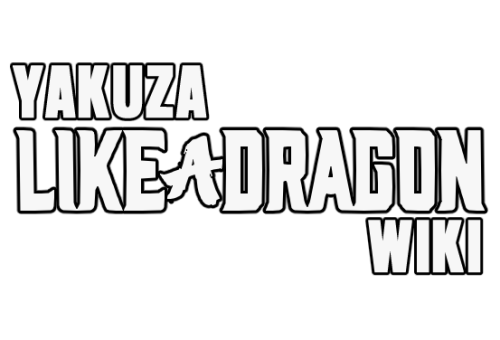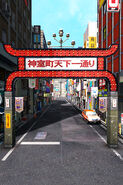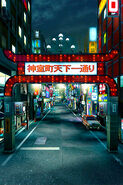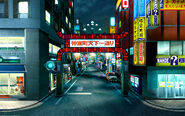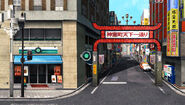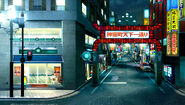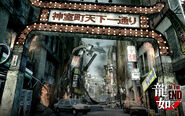No edit summary Tag: Source edit |
Tag: Visual edit |
||
| (33 intermediate revisions by 12 users not shown) | |||
| Line 1: | Line 1: | ||
| − | {{Location |
+ | {{Location Infobox |
|located_in = [[Tokyo]] |
|located_in = [[Tokyo]] |
||
|type=District |
|type=District |
||
|romanized=Kamuro-chō |
|romanized=Kamuro-chō |
||
| − | | |
+ | |jp=神室町 |
| − | | |
+ | |img = <gallery> |
MapResize0.png|Y0 |
MapResize0.png|Y0 |
||
Map.jpg|Y1 |
Map.jpg|Y1 |
||
| Line 11: | Line 11: | ||
Kamurochomap.jpg|Y4 |
Kamurochomap.jpg|Y4 |
||
</gallery>}} |
</gallery>}} |
||
| − | '''Kamurocho''' ({{JP|神室町}}, ''Kamuro-chō'' |
+ | '''Kamurocho''' ({{JP|神室町}}, ''Kamuro-chō'') is a district in Tokyo. It is based on {{WP|Kabukichō|Kabukicho}}, the real-life entertainment and red light district of Tokyo. |
| + | |||
| + | It is the most featured city in the [[Like a Dragon|''Yakuza'']] series. Every main series game (with the sole exception of ''[[Like a Dragon Gaiden: The Man Who Erased His Name]]''), as well as each game in the ''Judgment'' and ''Kurohyou'' spin-off series, features Kamurocho as an explorable city. It is the sole explorable city in ''[[Yakuza]]''/''[[Yakuza Kiwami]]'', ''[[Yakuza 4]]'', ''[[Kurohyou: Ryu Ga Gotoku Shinsho]]'', and ''[[Judgment]]''. |
||
Kamurocho is the nightlife capital of Japan. As [[Tojo Clan]] territory, the district is home to many yakuza and is often the setting of large and small-scale disputes between the Tojo Clan and their rivals such as the [[Omi Alliance]], as well as intra-clan conflicts between Tojo subsidiaries. The [[Millennium Tower]], a skyscraper landmark at the center of Kamurocho, was constructed by the [[Dojima Family]] and is a symbol of the Tojo Clan's power in the district. |
Kamurocho is the nightlife capital of Japan. As [[Tojo Clan]] territory, the district is home to many yakuza and is often the setting of large and small-scale disputes between the Tojo Clan and their rivals such as the [[Omi Alliance]], as well as intra-clan conflicts between Tojo subsidiaries. The [[Millennium Tower]], a skyscraper landmark at the center of Kamurocho, was constructed by the [[Dojima Family]] and is a symbol of the Tojo Clan's power in the district. |
||
| Line 17: | Line 19: | ||
When not pursuing the main story, [[Kazuma Kiryu]] can explore, shop, and even unwind at various locales dotted throughout the city. The specific businesses and activities available change from game to game, as like a real-life city, Kamurocho changes over the course of the series, with various businesses moving in and out of the district over the years. Such businesses include, but are not limited to: sports facilities, pawn shops, hostess clubs, a strip club, bars, and restaurants. |
When not pursuing the main story, [[Kazuma Kiryu]] can explore, shop, and even unwind at various locales dotted throughout the city. The specific businesses and activities available change from game to game, as like a real-life city, Kamurocho changes over the course of the series, with various businesses moving in and out of the district over the years. Such businesses include, but are not limited to: sports facilities, pawn shops, hostess clubs, a strip club, bars, and restaurants. |
||
| − | Each game also features [[substories]] set within Kamurocho. In these missions, the player can aid those in despair realize their otherwise impossible dreams, or to simply socialize and bond with the residents to better understand how and why they chose to eke out a living within the city, in spite of the dangers, suffering, and hardships that arose from its omnipresent vice. |
+ | Each game also features [[:Category:Substories|substories]] set within Kamurocho. In these missions, the player can aid those in despair to realize their otherwise impossible dreams, or to simply socialize and bond with the residents to better understand how and why they chose to eke out a living within the city, in spite of the dangers, suffering, and hardships that arose from its omnipresent vice. |
==Notable Locations== |
==Notable Locations== |
||
| + | === Streets and Areas === |
||
| ⚫ | |||
| + | * [[Tenkaichi Street]]: Home to the famous Kamurocho gate. |
||
| + | * [[Tenkaichi Alley]]: An alleyway between Tenkaichi Street and Nakamichi Street. Home to [[Public Park 3|Public Park No. 3]]. |
||
| + | * [[Nakamichi Street]]: The central street of Kamurocho. |
||
| + | * [[Nakamichi Alley]]: An alleyway between Nakamichi Street and Pink Street |
||
| + | * [[Pink Street]]: A street home to various adult entertainment establishments. It used to have a northern section, but it was consumed by Little Asia after it's expansion. |
||
| + | * Pink Alley: A small back alley between Pink Street and Senryo Avenue. |
||
| + | * Senryo Avenue: A long avenue easternmost of Kamurocho. |
||
| + | * [[Park Boulevard]]: A northeastern boulevard, bordering West Park and home to the Dragon Palace |
||
| ⚫ | |||
| ⚫ | |||
| ⚫ | |||
| ⚫ | * [[West Park]]: A large city park located in northeast Kamurocho that is home to a homeless encampment and the entrance to the subterranean gambling and pleasure den [[Purgatory]]. Most of West Park is demolished after 2005 to make room for the [[Kamurocho Hills]] office tower; a large office complex built by [[Majima Construction]]. |
||
| ⚫ | |||
| + | |||
| + | === Story-relevant Locations === |
||
| ⚫ | |||
*[[Stardust]]: A host club located across the street from Serena. |
*[[Stardust]]: A host club located across the street from Serena. |
||
*[[Millennium Tower]]: A skyscraper at the heart of Kamurocho. |
*[[Millennium Tower]]: A skyscraper at the heart of Kamurocho. |
||
| ⚫ | |||
| ⚫ | |||
| ⚫ | |||
| ⚫ | *[[West Park]]: A large city park located in northeast Kamurocho home to a homeless encampment and the entrance to the subterranean gambling and pleasure den [[Purgatory]]. Most of West Park is demolished after |
||
*[[Shangri-La]]: A Soapland located on the corner of E Taihei Boulevard and N Senryo Avenue. Shut down as of 2006, courtesy of the [[Goro Majima|Mad Dog of Shimano]]. As of 2019, the run-down building still stands. |
*[[Shangri-La]]: A Soapland located on the corner of E Taihei Boulevard and N Senryo Avenue. Shut down as of 2006, courtesy of the [[Goro Majima|Mad Dog of Shimano]]. As of 2019, the run-down building still stands. |
||
| + | *[[Dragon Palace]]: An abandoned cabaret club which was turned into a homeless shelter after West Park was demolished. Also serves as a casino and gambling hall. |
||
| ⚫ | |||
| ⚫ | |||
| ⚫ | |||
*[[Kamuro Castle]]: A former restaurant-turned-yakuza rehabilitation center for the [[Honest Living Association]] located in [[Nakamichi Alley]]. |
*[[Kamuro Castle]]: A former restaurant-turned-yakuza rehabilitation center for the [[Honest Living Association]] located in [[Nakamichi Alley]]. |
||
| + | *[[Sky Finance]]: A credit company owned by [[Shun Akiyama]], located above New Serena. Infamous for offering loans not by credit rating, but by giving tests of character. |
||
| + | *[[Yagami Detective Agency]]: A detective agency on Nakamichi Alley run by [[Takayuki Yagami]]. |
||
| ⚫ | |||
| − | == |
+ | === Shops === |
| + | |||
| + | * [[Don Quijote]]: A retail store chain in Nakamichi Street. |
||
| + | * [[Poppo]]: A convenience store chain, with four locations in Kamurocho. |
||
| + | * [[Ebisu Pawn]]: A pawn shop located in Nakamichi Alley. |
||
| + | |||
| + | === Restaurants, Eateries and Bars === |
||
| + | |||
| + | * [[Akaushimaru]]: A beef restaurant chain. It was replaced by [[Yoshinoya]] as of 2021. |
||
| + | * [[Cafe Alps|Café Alps]]: Established in 1971, it's an European-style café. |
||
| + | * [[Smile Burger]]: A fast food chain, focusing in hamburgers. Has two locations in Kamurocho, being in Nakamichi Street and Theater Square |
||
| + | * [[Wild Jackson]]: A fast food chain. |
||
| + | * [[Wette Kitchen]]: A burger chain which uses organic ingredients |
||
| + | * [[Kyushu No. 1 Star]]: A ramen diner that opened prior to 2005. |
||
| + | * [[Bantam]]: A bar east of the Millennium Tower formerly named Bacchus. |
||
| + | * [[Kanrai]]: A Korean yakiniku restaurant located north of Kamurocho. Popular with celebrities. |
||
| + | |||
| + | === Entertainment and Nightlife === |
||
| + | *[[Club SEGA]]: A chain of amusement centers run by Sega with two locations in Kamurocho. One is in Theater Square, and the other is on Nakamichi Street. |
||
| + | *[[Yoshida Batting Center]]: A batting center in the Hotel District. |
||
| + | *[[Volcano]]: A pachinko parlor in Theater Square. |
||
| + | *[[Club Shine]]: A cabaret club in Pink Street. It was replaced by [[Queen Rouge]] prior to 2019 |
||
| + | * [[JeweL|Club JeweL]]: A cabaret club in Shichifuku Street. It was closed down after 2012. |
||
| + | *[[Mach Bowl]]: A bowling alley in Theater Alley. Was closed down between December 2012 and 2016 |
||
| + | *[[Karaokekan]]: A chain of karaoke rooms. |
||
| ⚫ | |||
| + | *[[L'Amant]]: A casino, located under a fishing pond named [[Koi Bride]] |
||
| + | |||
| + | ==Trivia== |
||
* In ''[[Yakuza 6]]'', most of northeast Kamurocho is inaccessible north of Shichifuku Street and east of the Hotel District. The Champion District is also inaccessible. The development team could not recreate the whole of Kamurocho in the new Dragon Engine built for Yakuza 6 in the time allotted for development. The second game made using the Dragon Engine, [[Yakuza Kiwami 2]], once again features the entire Kamurocho map, although the Champion District is smaller than before. |
* In ''[[Yakuza 6]]'', most of northeast Kamurocho is inaccessible north of Shichifuku Street and east of the Hotel District. The Champion District is also inaccessible. The development team could not recreate the whole of Kamurocho in the new Dragon Engine built for Yakuza 6 in the time allotted for development. The second game made using the Dragon Engine, [[Yakuza Kiwami 2]], once again features the entire Kamurocho map, although the Champion District is smaller than before. |
||
| − | * |
+ | *In the first Yakuza game, Kiryu could watch an advertisement depicting a mahjong game in progress if he stood in the right place around Theater Square. Kiryu himself cannot play mahjong in the original game, but it is an available minigame in the remake. |
| ⚫ | |||
| − | * Kamurocho is the setting of the ''Black Panther'' series and ''[[Judgment]]'', both of which are spin-offs of the main ''Yakuza'' series, but do not feature any main characters from the main series. |
||
| ⚫ | |||
==Gallery== |
==Gallery== |
||
| − | ===Yakuza 0=== |
||
| − | <gallery> |
||
| − | TheaterSqSega0.png |
||
| − | TheaterSq0.png |
||
| − | ShichifukuSt0.png |
||
| − | HotelDistrict0.png |
||
| − | </gallery> |
||
| − | ===Yakuza Kiwami 1=== |
||
| − | <gallery> |
||
| − | TheaterSqSegaK1.png |
||
| − | TheaterSqK1.png |
||
| − | ShichifukuStK1.png |
||
| − | HotelDistrictK1.png |
||
| − | </gallery> |
||
===Yakuza 2=== |
===Yakuza 2=== |
||
<gallery> |
<gallery> |
||
Screenshot8 yakuza2 8398952182 o.jpg |
Screenshot8 yakuza2 8398952182 o.jpg |
||
| − | </gallery> |
||
| − | ===Yakuza 3=== |
||
| − | <gallery> |
||
| − | Wallpaper3 yakuza3 8387595588 o.jpg |
||
</gallery> |
</gallery> |
||
===Yakuza 5=== |
===Yakuza 5=== |
||
| Line 75: | Line 99: | ||
WP type01 1920kamuro.jpg |
WP type01 1920kamuro.jpg |
||
</gallery> |
</gallery> |
||
| + | |||
| − | {{Template:Districts}} |
||
[[Category:Locations]] |
[[Category:Locations]] |
||
[[Category:Kamurocho]] |
[[Category:Kamurocho]] |
||
| Line 91: | Line 115: | ||
[[Category:Yakuza 6 Locations]] |
[[Category:Yakuza 6 Locations]] |
||
[[Category:Yakuza: Like a Dragon Locations]] |
[[Category:Yakuza: Like a Dragon Locations]] |
||
| + | [[Category:Kurohyou 2: Ryu Ga Gotoku Ashura-hen Locations]] |
||
| + | [[Category:Kurohyou: Ryu ga Gotoku Shinsho Locations]] |
||
Latest revision as of 23:49, 17 April 2024
Kamurocho (神室町, Kamuro-chō) is a district in Tokyo. It is based on KabukichoWP, the real-life entertainment and red light district of Tokyo.
It is the most featured city in the Yakuza series. Every main series game (with the sole exception of Like a Dragon Gaiden: The Man Who Erased His Name), as well as each game in the Judgment and Kurohyou spin-off series, features Kamurocho as an explorable city. It is the sole explorable city in Yakuza/Yakuza Kiwami, Yakuza 4, Kurohyou: Ryu Ga Gotoku Shinsho, and Judgment.
Kamurocho is the nightlife capital of Japan. As Tojo Clan territory, the district is home to many yakuza and is often the setting of large and small-scale disputes between the Tojo Clan and their rivals such as the Omi Alliance, as well as intra-clan conflicts between Tojo subsidiaries. The Millennium Tower, a skyscraper landmark at the center of Kamurocho, was constructed by the Dojima Family and is a symbol of the Tojo Clan's power in the district.
When not pursuing the main story, Kazuma Kiryu can explore, shop, and even unwind at various locales dotted throughout the city. The specific businesses and activities available change from game to game, as like a real-life city, Kamurocho changes over the course of the series, with various businesses moving in and out of the district over the years. Such businesses include, but are not limited to: sports facilities, pawn shops, hostess clubs, a strip club, bars, and restaurants.
Each game also features substories set within Kamurocho. In these missions, the player can aid those in despair to realize their otherwise impossible dreams, or to simply socialize and bond with the residents to better understand how and why they chose to eke out a living within the city, in spite of the dangers, suffering, and hardships that arose from its omnipresent vice.
Notable Locations[]
Streets and Areas[]
- Tenkaichi Street: Home to the famous Kamurocho gate.
- Tenkaichi Alley: An alleyway between Tenkaichi Street and Nakamichi Street. Home to Public Park No. 3.
- Nakamichi Street: The central street of Kamurocho.
- Nakamichi Alley: An alleyway between Nakamichi Street and Pink Street
- Pink Street: A street home to various adult entertainment establishments. It used to have a northern section, but it was consumed by Little Asia after it's expansion.
- Pink Alley: A small back alley between Pink Street and Senryo Avenue.
- Senryo Avenue: A long avenue easternmost of Kamurocho.
- Park Boulevard: A northeastern boulevard, bordering West Park and home to the Dragon Palace
- Theater Square: A public square home to various shopping and entertainment businesses.
- Champion District: A labyrinthine area of old ramshackle bar and cafe buildings.
- Hotel District: A district of hotels in northwest Kamurocho.
- West Park: A large city park located in northeast Kamurocho that is home to a homeless encampment and the entrance to the subterranean gambling and pleasure den Purgatory. Most of West Park is demolished after 2005 to make room for the Kamurocho Hills office tower; a large office complex built by Majima Construction.
- Little Asia: A ghetto for Chinese and other mainland Asian immigrants, which was later redeveloped with help of the Saio Triad after a fire. It was then closed off in 2016 for renovation due to another fire.
Story-relevant Locations[]
- Serena: A bar on Tenkaichi Street. It was shut down near the end of 2005 and reopens as New Serena between 2007 and 2009.
- Stardust: A host club located across the street from Serena.
- Millennium Tower: A skyscraper at the heart of Kamurocho.
- Shangri-La: A Soapland located on the corner of E Taihei Boulevard and N Senryo Avenue. Shut down as of 2006, courtesy of the Mad Dog of Shimano. As of 2019, the run-down building still stands.
- Dragon Palace: An abandoned cabaret club which was turned into a homeless shelter after West Park was demolished. Also serves as a casino and gambling hall.
- Kamuro Castle: A former restaurant-turned-yakuza rehabilitation center for the Honest Living Association located in Nakamichi Alley.
- Sky Finance: A credit company owned by Shun Akiyama, located above New Serena. Infamous for offering loans not by credit rating, but by giving tests of character.
- Yagami Detective Agency: A detective agency on Nakamichi Alley run by Takayuki Yagami.
- Bar Tender: A bar on Taihei Boulevard.
Shops[]
- Don Quijote: A retail store chain in Nakamichi Street.
- Poppo: A convenience store chain, with four locations in Kamurocho.
- Ebisu Pawn: A pawn shop located in Nakamichi Alley.
Restaurants, Eateries and Bars[]
- Akaushimaru: A beef restaurant chain. It was replaced by Yoshinoya as of 2021.
- Café Alps: Established in 1971, it's an European-style café.
- Smile Burger: A fast food chain, focusing in hamburgers. Has two locations in Kamurocho, being in Nakamichi Street and Theater Square
- Wild Jackson: A fast food chain.
- Wette Kitchen: A burger chain which uses organic ingredients
- Kyushu No. 1 Star: A ramen diner that opened prior to 2005.
- Bantam: A bar east of the Millennium Tower formerly named Bacchus.
- Kanrai: A Korean yakiniku restaurant located north of Kamurocho. Popular with celebrities.
Entertainment and Nightlife[]
- Club SEGA: A chain of amusement centers run by Sega with two locations in Kamurocho. One is in Theater Square, and the other is on Nakamichi Street.
- Yoshida Batting Center: A batting center in the Hotel District.
- Volcano: A pachinko parlor in Theater Square.
- Club Shine: A cabaret club in Pink Street. It was replaced by Queen Rouge prior to 2019
- Club JeweL: A cabaret club in Shichifuku Street. It was closed down after 2012.
- Mach Bowl: A bowling alley in Theater Alley. Was closed down between December 2012 and 2016
- Karaokekan: A chain of karaoke rooms.
- Maharaja: a disco club on Shichifuku Street. Shut down some time after 1988, as the club closed nationwide.
- L'Amant: A casino, located under a fishing pond named Koi Bride
Trivia[]
- In Yakuza 6, most of northeast Kamurocho is inaccessible north of Shichifuku Street and east of the Hotel District. The Champion District is also inaccessible. The development team could not recreate the whole of Kamurocho in the new Dragon Engine built for Yakuza 6 in the time allotted for development. The second game made using the Dragon Engine, Yakuza Kiwami 2, once again features the entire Kamurocho map, although the Champion District is smaller than before.
- In the first Yakuza game, Kiryu could watch an advertisement depicting a mahjong game in progress if he stood in the right place around Theater Square. Kiryu himself cannot play mahjong in the original game, but it is an available minigame in the remake.
- In Yakuza: Like a Dragon, the Don Quijote store present in all other games in the series is under construction in 2000 and has been replaced by a police station in 2019, perhaps indicating the expiry of rights to use the Don Quijote name and branding in the series.
